The consortium planned six multiplier events and continues to present the project on numerous other occasions and conferences. They also produce peer-reviewed papers and talks which can be found here. To read about the Multiplier Events, scroll below.
MULTIPLIER EVENT 06: 'THE IMPACT OF ARCHITECTURE'S AFTERLIFE ON OTHER SECTORS'
Universitat Politecnica de Valencia, VIBRARCH 3rd International Biennial of Research in Architecture
Date: August 31 - September 2 2022
On November 9 2022, the partners presented their O6 Multiplier Event during VibrArch 3rd Valencia International Biennial of Research in Architecture. The Multiplier Event was dedicated to the Afterlife reports to other sectors, and the partners presented: “Work-package 4h: Formulation of impact upon other sectors” and “WP 4g: Formulation of impact upon non- construction sectors: creative industries in North and South of Europe.”
Attendees (organizers): Michela Barosio (Politecnico di Torino); Dag Boutsen (KU Leuven); Mia Roth Cerina (Sveučilište U Zagrebu); Carla Sentieri Omarrementeria (Universitat Politècnica de València), Hanne Vanreusel (KU Leuven).
Attendees (guests): Pablo Arias, Maria Jose Ochoa, Daphne Gosselin Calvignac, Robiel Manzeta Felix, Dayana Acosta Medina, Alberto Quintana Gallardo, Vanesa Celina Saez, Annette Davis, Tamia Guevara Pettersen, Colm Mac Aoidh, Farhad Morterage, Brian E. Sinclair, Nooshin Esmaeili, Luis Bosch Roig, Susana Inarra Abad, Angeles Mas Tomas, Victor Fernandez Mora, Coral Albelda-Estelles Ness, Irene Hwang, Marisol Vidal, Alexandra Alegre, Tomas Vidal Garcia, Diego Sanz Almela, Airanna Guardiola Vigora, Placido Lizancos, Patrick Hoffmann
Meeting Outcomes:
1. Dissemination of the results of the survey, in particular in relationship to Flow 3 and 4: Creative Industries and Others (IO2).
2. Dissemination of Intellectual Output 02, that is, “Work-package 4h: Formulation of impact upon other sectors” and “WP 4g: Formulation of impact upon non- construction sectors: creative industries in North and South of Europe.”
3. Discussions with the audience on topics related to curricula and their relation to professions other than architecture.
4. Discussion with the External Advisory Board and guests about the interviews and overall intent of the project.
.jpeg)
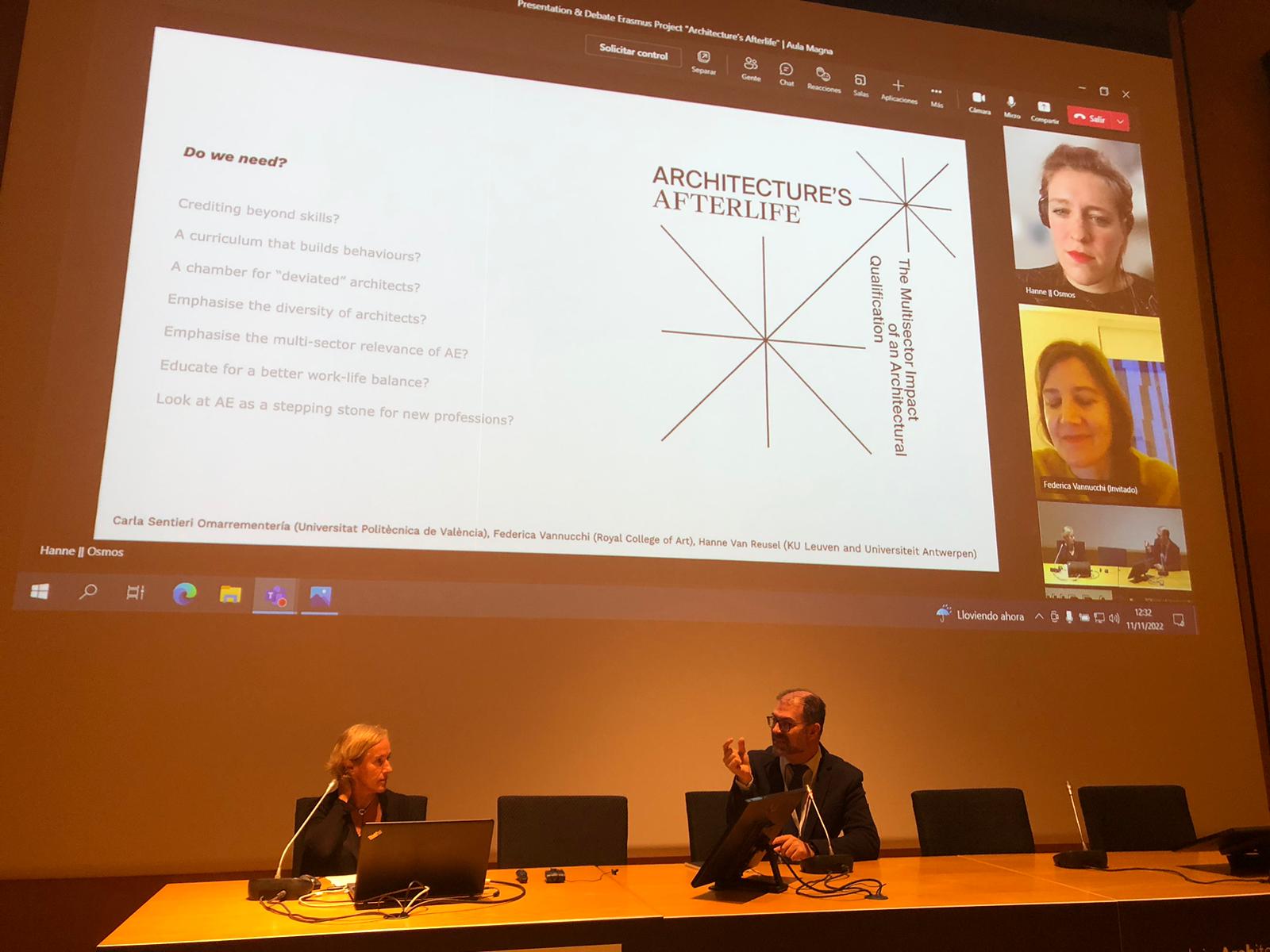
See the conference program here and the presentations here.
________________________________________________
MULTIPLIER EVENT 05: 'THE PEDAGOGIC IMPACT OF ARCHITECTURE'S AFTERLIFE'
Universitat Politecnica de Madrid, 2022 Annual Conference of the European Association of Architectural Education
Date: August 31 - September 2 2022
On September 1 2022, the partners presented their O5 Multiplier Event during the 2022 EAAE Annual Conference + General Assembly. The Multiplier Event was dedicated to the Afterlife reports to higher education policy makers, and the partners presented Wp 4f: Pedagogic impact of the study for HE curricula.
As Keynote speaker, Dag Boutsen presented some of the new and reinformed insights, concerns, and difficulties in relation to the architectural profession that have emerged through the Architecture’s Afterlife research project. In the presentation Dag links these to a debate on the need to re-discuss these insights, possible changes and ameliorations that are in line with contemporary needs as brought up by the New European Bauhaus. Inclusivity, collective thinking, bottom-up approaches, human sustainability, ecological philosophy… we can only address these through a broad range of competences.
Furthermore, the outcomes of the Architecture’s Afterlife research project are embedded in the broader theme of ‘internationalization’ through subtopics like ‘interconnected Europe’, architecture (as) a mindset, the context of Bologna, the role of competent authorities, the topic of inclusivity and the aspects belonging to lifelong learning. A focus is being proposed on the acquisition of two competences as stipulated in article 46 of the European Directives. Two skills about understanding the relationship between people and buildings, and about understanding the role of the architect in society can be interpreted in such a way that they bridge education and research, curricula and practice, and professional and disciplinary skills. The debate that follows the presentation brings together key transnational organizations that represent architecture.
Hanne Van Reusel presented a paper co-authored with Dag Boutsen and Michela Barosio on “An anthology for the invisible beyond architect-ure”. This discussed some of the findings of the Architecture’s Afterlife study in relation to the flow 3 - the architects that are currently working in the creative sector. The presentation and poster exhibition have as main objective to show and render visible the diverse trajectories architects can take. Through showcasing five examples from interviewees of the research, the presentation reveals the invisible values and communities, the in- of the output, and calls for a chamber of deviated architects.
Mia Roth Cerina presented a paper co-authored with Federica Vannucchi on “Multidisciplinarity in Action: Defining Collaborative Design”. This discussed the findings on Architecture’s Afterlife in regard to architecture graduates exploring collaborative, inclusive, interdisciplinary practices, but also personal competencies and individual responsibilities. The Architecture’s Afterlife Questionnaire has highlighted that the most used competences are both “personal competences” and “cooperation competences” but while the former are adequately taught in school, the latter are not. Instead, “diversity competences” are in between.
Meeting Outcomes:
1. Dissemination of the results of the survey, in particular in relationship to Flow 2: Related to Architecture (IO2).
2. Dissemination of Intellectual Output 02, that is, Wp 4f: Pedagogic impact of the study for HE curricula
3. Discussions with the speakers of the roundtable and audience on topics related to curricula and their relation to the profession.
.
Attendees:
Anna Ramos, Oya Atalaya Franck, Thomas Vonier, Ilaria Valente, Ugis Bratuskin, Alessandro Massarente, Karolina Tilkowska, Manuel Blanco, Ognen Marina, Egle Navickiene, Ivan Cabrera I fausta, Marisol Vidal, Ana Souto, Riva Lava, Roberto Cavallo, Anne savoy, Sandra Rihs, Cristina Careva, Alejandro Gonzalez, Patrick Flynn, Rachel Armstrong, Tommaso Listo, Damir Mance, Oana Paval, Jose Pedro Souba, Teresa Calix, Effrosyni Roussou, Christina Panayi, Iryna Matsevko, Daria Ozhyanova, Hans Denfelden, Madeleine Maskant, Marleena Yli-Ayno, Ollipand Koponen, Osamu Okamura, Yves Schoonjans, Ernesto Fenollosa, Luis Bosch Roig, Mildred Vander Zuan, Magdalena Kozien, Rafael Zaniska, Lisa Beisswanger, Peter Strauss, Cian Farrel, sally stewart, Dalibor Hlavacek, David Escudero, Rodrigo De la O, Martin Weischer, Arianna Scaiolil Dubravko Bacic, Ruth Schagemann, olga Mihalikowa, Ole gustavsen, Jakob Knudsen, Massimo santanicchia, Garry Miley, Fabrizio Apollonio, Oliver Sacher, Krzysztof Kosezewski, Neslihan Dostoglu, Emel Birer, Jorg Schroder, Resmiye Apartatun, Mayka Garcia Hipoa, Garius Naya Villaverde, Tadeja Zupanic, Placido Lizangos, Sophia Vazquez Diaz, Zaira Garcia Requejo, Miguel Abelleira, Sofia Leoni, Camilla Forina, Valeria federighi, Rossella Gugliotta.


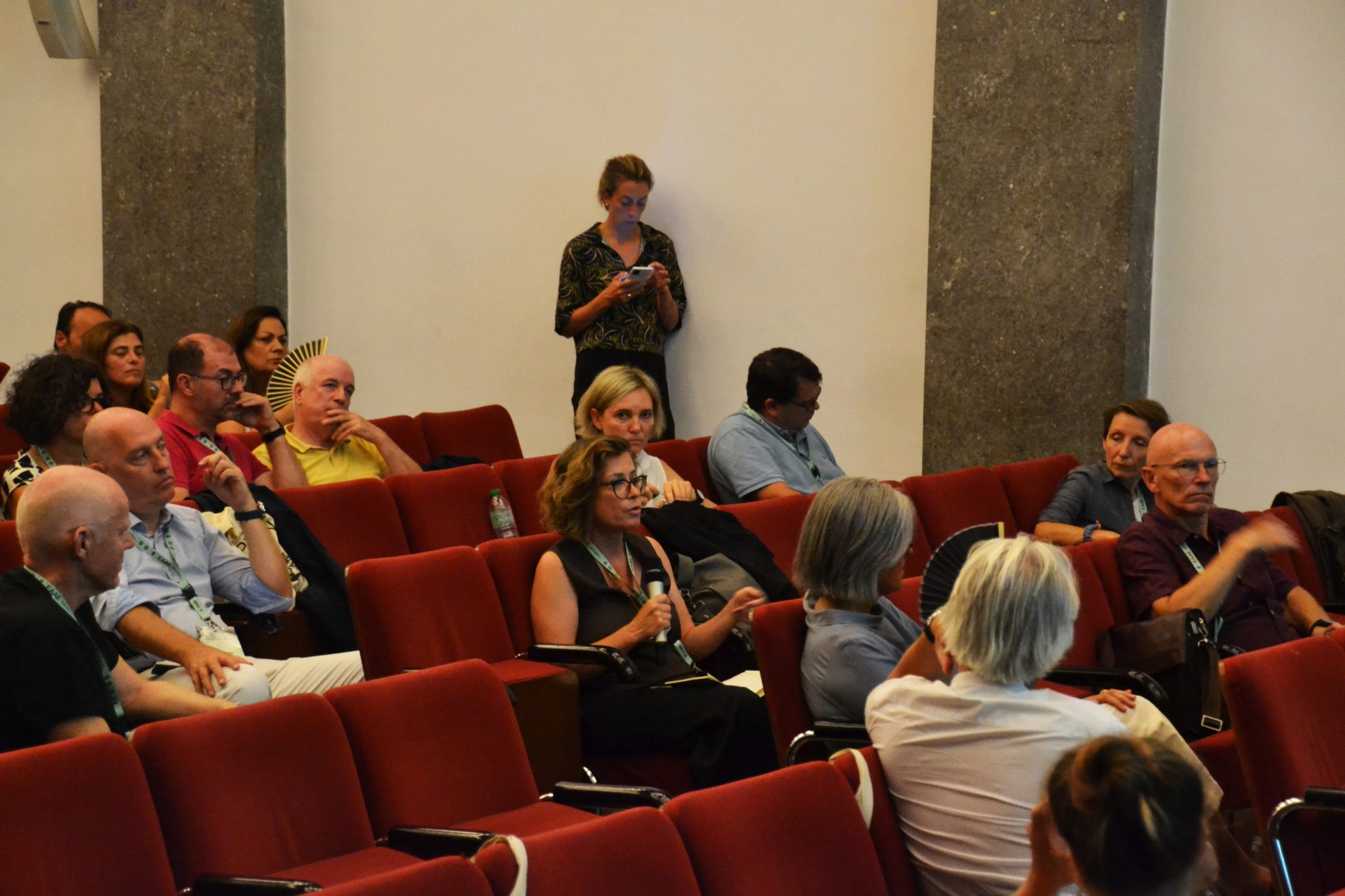

Check out the presentation here.
________________________________________________
MULTIPLIER EVENT 04: 'ARCHITECTURAL EDUCATION IN DIFFERENT CONTEXTS'
Polytechnic University of Valencia, Valencia (on-line)
Date: November 26, 2021
Attendees (organizers): Harriet Harriss (Royal College of Art); Michela Barosio (Politecnico di Torino); Dag Boutsen (KU Leuven); Haydée De Loof (KU Leuven); Johan De Walsche (Universiteit Antwerpen); Mia Roth Cerina (Sveučilište U Zagrebu); Andrea Čeko (Sveučilište U Zagrebu); Carla Sentieri Omarrementeria (Universitat Politècnica de València); Federica Vannucchi (Royal College of Art).
Attendees (speakers): Beth Hughes (Head of Programme, Architecture MA, Royal College of Art (England); Dag Boutsen, (Dean, KU Leuven Faculty of Architecture (Belgium); Carla Bartolozzi (PhD, Dean, Collegio di Architettura, Politecnico di Torino (Italia); Bojan Baletić (PhD, Dean, Faculty of Architecture, University of Zagreb (Croatia); Iván Cabrera (PhD, Dean, Faculty of Architecture,Universitat Politècnica de València (Spain)
Attendees (guests): Marco Trisciuoglio; Tonči Čerina; Santiago Gomes; Andrea Čeko; Sophie Van Campenhout; Alberto Bologna; Silvia Colmenares Vilata; Bojan Baletić; Elena Vigliocco; Valentina Modano; elena andonova; ana navarro; Eva Alvarez; christiano lepratti; Siniša Justić; Chrystala Psathiti; Hanne Vanreusel; Luka Korlaet; Tvrtko Jakovina.
On 26 November 2021, the partners met for our Fourth Multiplier Event entitled ARCHITECTURAL EDUCATION IN DIFFERENT CONTEXTS and addressed the Afterlife reports to Architecture education administrators. They invited higher education administrators of Architecture’s Afterlife partners’ five nations—Belgium, Croatia, England, Italy and Spain. The partners presented the findings of the Architecture’s Afterlife Survey, and in particular, the Intellectual Output 02, that is, (wp4d): Pedagogic Impact for Architecture curricula. In this event, the organizers, the presenters and the guests discussed how the partners’ schools organize their curricula, whether and how these schools include other programs besides architecture, the competences taught in architecture schools, what professions are ‘related’ to architecture, and the relationship between disciplinarity and interdisciplinarity in architecture curricula.
Meeting Outcomes:
1. Dissemination of the results of the survey, in particular in relationship to Flow 2: Related to Architecture (IO2).
2. Dissemination of Intellectual Output 02, that is, (wp4d): Pedagogic Impact for Architecture curricula
3. In-depth interviews higher education policy makers of Belgium, Croatia, England, Italy and Spain
4. Discussions with the audience on topics related to curricula and their relation to the profession.
5. Discussion with the External Advisory Board and guests about the interviews and overall intent of the project.
6. Compilation of minutes of the meeting which will become essential for the writing of Afterlife Reports (IO2) and Academic Papers (IO4).
.jpg)
Find out more about the program here and the introductory presentations here.
________________________________________________
MULTIPLIER EVENT 03: '(MIS)MATCHES BETWEEN ARCHITECTURAL EDUCATION AND PRACTICE'
Politecnico di Torino, Torino (on-line)
Date: October 01, 2021
On 1 October 2021, Architecture’s Afterlife hosted the third Multiplier Event entitled “(MIS)MATCHES BETWEEN ARCHITECTURAL EDUCATION AND PRACTICE” and addressed the Afterlife reports to architecture business and professional boards. The partners invited the head of professional bodies of the professional bodies of Architecture’s Afterlife partners’ five nations - Belgium, Croatia, England, Italy, and Spain - together with experts on professional bodies’ policy in the EU Member States. The partners presented the findings of the Architecture’s Afterlife Survey, and in particular, the Intellectual Output 02, that is, wp4e: Formulation of impact upon the construction industry. As an introduction to the guest speakers, the partners presented research comparing different study paths and ways to qualify for professional practice as an architect in the European context, comparing Belgium, Croatia, England, Italy, and Spain. In this event, the partners and the participants discussed how the practice of architecture is mediated, organized, and regulated by national and international professional bodies; what are the competencies acquired in architecture education and requested by the profession; and how “European” are the European professional bodies and the architect's practice that they represent. The guests, contributing their vision and their experiences, and in relation to the data and conclusions presented in the first part of the meeting, presented how professional bodies define the architect's profession but also, in some cases the definition of architectural schools’ curricula, as for the UK experience of RIBA. It was established the need to create an effective pan-European dialogue among the different national bodies.
Attendees (organizers): Harriet Harriss (Royal College of Art); Michela Barosio (Politecnico di Torino); Dag Boutsen (KU Leuven); Haydée De Loof (KU Leuven); Johan De Walsche (Universiteit Antwerpen); Mia Roth Cerina (Sveučilište U Zagrebu); Andrea Čeko (Sveučilište U Zagrebu); Santiago Gomes (Politecnico di Torino); Carla Sentieri Omarrementeria (Universitat Politècnica de València); Federica Vannucchi (Royal College of Art); Hanne Vanreusel (KU Leuven).
Attendees (speakers): Simon Allford (President of RIBA Royal Institute of British Architects (UK); Dirk Mattheeuws (ARW ARCHITECTEN, Belgium); Isabel Navarro (Colegio de Arquitectos de la Comunidad Valenciana (Spain); Robert Loher (Secretary of Chamber of Architects (Croatia); Francesco Miceli (President of the CNAPP National Chamber of Architects (Italy); Georg Pendl (President of ACE Architects’ Council of Europe).
Attendees (general audience): Thomas Vonier (President, International Union of Architects), Tonči Čerina (roth&čerina), Jan Verbist (CATALPA architectenbureau), Schlesinger (Bundesarchitektenkammer), Marnik Dehaen (Fédération royale des Sociétés d'Architectes de Belgique FAB), Ivan Cabrera i Fausto (Universitat Politècnica de València), Simona Canepa (Politecnico di Torino), Dora Gorenak (EASA), Peter Jaeger (Architetti), Isil Ruhi-Sipahioglu (TOBB University of Economics and Technology), Alessandro Cimenti (Studioata, Presidente presso Fondazione per l'architettura Torino), Maja Furlan Zimmerman (x.3.m. d.o.o.), Sergio de Miguel (estudio de arquitectura hand madrid), Rodrigo Carbajal (ESTUDIO CARBAJAL SEVILLA), Tea Truta (Institute of Art History Zagreb), Nevena Keresa (Vienna), Wajiha Arshad (SCHIATTARELLA ASSOCIATI), Ida Križaj Leko (DeltLab)
Read more about the program and the speakers here. The introductory presentation can be found here.
________________________________________________
MULTIPLIER EVENT 02: 'ARCHI-TECHNOLOGIES: FROM ARCHITECTURAL CREATIVITY TO TECH DESIGN THINKING'
KU Leuven, Brussels (on-line)
Date: May 21, 2021
The Architecture’s Afterlife project hosted its second Multiplier Event dedicated to creative industries and, in particular, to graduates who have studied architecture and find themselves working on technology while engaging in the interaction between the built world and digital space. The program was articulated in three parts. In the first part, the partners shared some preliminary results of the Afterlife survey, including that, among the survey participants, 36% architecture graduates have never worked as architects, and that the work-life balance is quite poor for architecture and even poorer for individuals who combine architecture with related sectors. Regarding the competences acquired in the university years, the majority of the participants indicated “personal competencies” such as determination, work ethics, and endurance, proving that an architectural education has a very profound impact on how people develop their personality. The second part of the event was organized as an interactive dialogue with eight practitioners who were invited because of their work in creative industries and their particular focus on the use of technology. In this part, the partners projected a video compilation of the eighth speakers’ short presentations on their work. After the presentations, the partners asked the speakers a series of questions using a system of Interactive live polling.
Questions included the speakers’ definition of themselves as architects, their education, and professional trajectory. As the conversation was open to the audience in the last part, the discussion verted on the importance of the legal status of owning an architect’s title and its value within a social context. However, “the biggest potential of an architectural education is not being able to clearly define, or to frame, what architects are doing, it is actually the biggest opportunity that architectural education is providing for everybody” as Ognen Marina had put it. This education is profoundly based on creativity understood as a “kind of disposition that fosters opening up new ways that encourages search and inquiry” in Johan De Walsche words who recalled Elliot Eisner’s Arts and the Creation of Mind (2003). From there the question is an education that is not simply based on the usual STEM (science, technology, engineering and mathematics sciences) but on STEAM, where A indicates Art & Architecture.
Meeting Outcomes: 1. Dissemination of the survey 2. In-depth interviews with paradigmatic cases coming form the creative industries. Each of the speakers have presented their careers and answered specific questions. 3. Interviews with the audience on topics related to the intersection between architecture and creative industries. . 4. Discussion with the External Advisory Board and guests about the interviews and overall intent of the project. 5. Compilation of minutes of the meeting which will become essential for the writing of Afterlife Reports (IO2) and Academic Papers (IO4).
Attendees (organizers): Harriet Harriss (Royal College of Art); Michela Barosio (Politecnico di Torino); Dag Boutsen (KU Leuven); Haydée De Loof (KU Leuven); Johan De Walsche (Universiteit Antwerpen); Mia Roth Cerina (Sveučilište U Zagrebu); Carla Sentieri Omarrementeria (Universitat Politècnica de València); Federica Vannucchi (Royal College of Art); Hanne Van Reusel (KU Leuven).
Attendees: Kasper Jordaens (Research Coordinator, Polymath Lab at LUCA School of Arts); Chris Hildrey (Principal, Hildrey Studio); Miriam Bellard (Art Director : Visual Development, Rockstar North); Matt Jones (Principal Designer, Google AI); Pier Paolo Peruccio (Architect, Professor of Design PoliTo, Director SYDERE center); Karel Burssens (Transdisciplinary Artist); Avelina Prat (Film Director), Ximo Peris (Art Director); Anna-Maria Meister (TU Darmstadt); Begum Aktas (Altınbaş Üniversitesi); Diem NgTr (student Faculty of Architecture KU Leuven); Ivan Cabrera i Fausto (Universitat Politècnica de València); Jo Meers (Faculty of Design Sciences of the University of Antwerp); Marnik Dehaen (Conseil National de l’Ordre des Architectes CNOA); Nevena Keresa (Vienna); Ognen Marina (Faculty of Architecure, Skopje); Patrick Flynn (TU Dublin); Philémon Wachtelaer (ARCHI.be); Piuhan; Rolf Hughes (Faculty of Architecture KU Leuven); Rossella Gugliotta (Politecnico di Torino); Santiago Gomes (Politecnico di Torino)
Find our more about the program here and the presentation here.

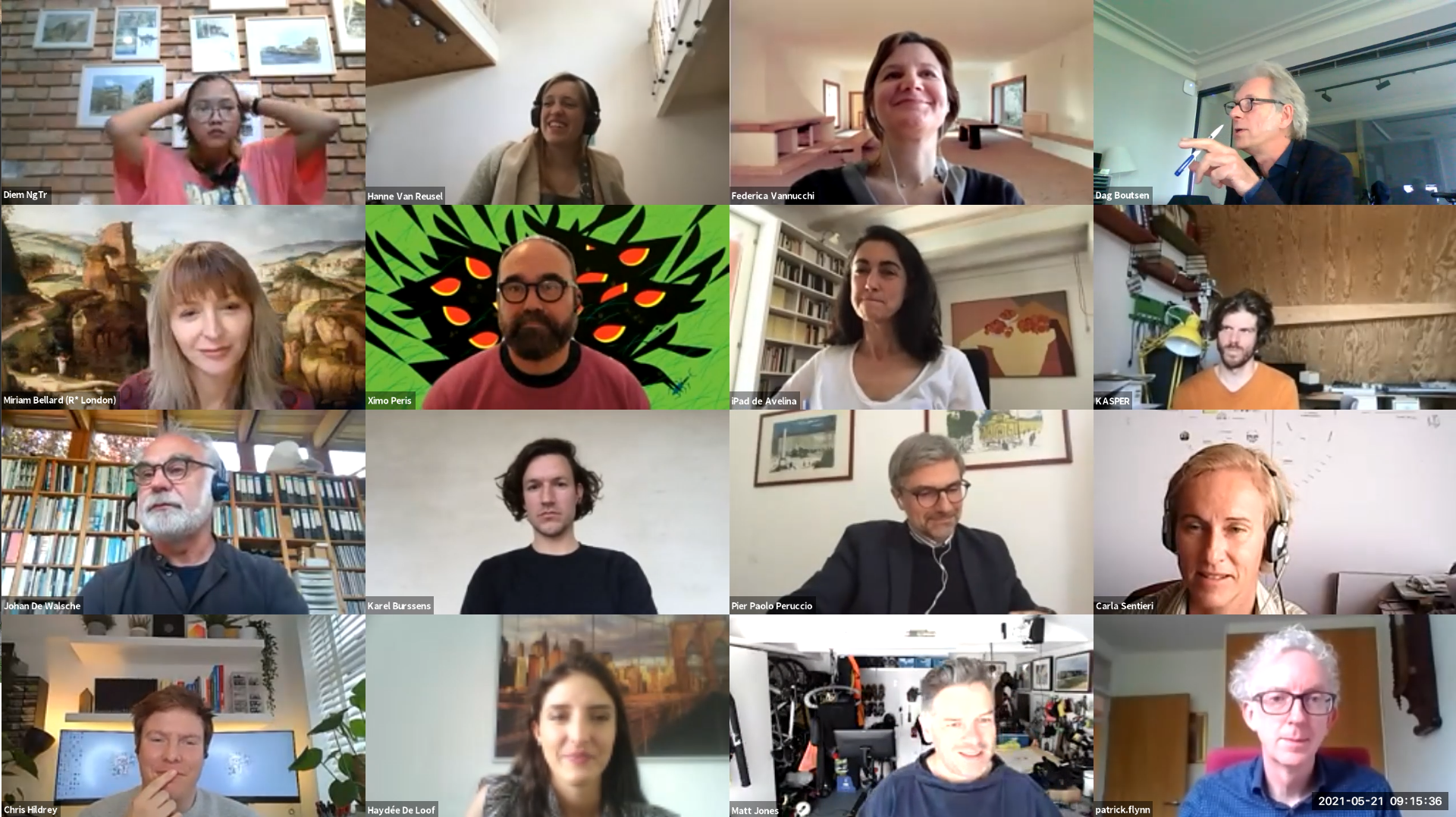
________________________________________________
MULTIPLIER EVENT 01: 'ARCHIPELAGO OF PRACTICE'
University of Antwerp, Antwerp (on-line)
Date: February 19, 2021
On 19 February 2021, Architecture’s Afterlife hosted the first Multiplier Event entitled “Archipelago of Practice.” Deans, directors and representatives of different EU architecture schools, representatives of EAAE, IUA, RIBA, ACSA, ARCC, representatives of architecture businesses and professional bodies, and the External Advisory Board of the study, gathered together for the on-line event. The ME O1 consisted of twelve in-depth interviews of practitioners who have studied architecture and have pursued a professional path different from the traditional practice of architecture. After the interviews, the partners, the speakers and the guests engaged in a conversation regarding the presentations and the scope of the study. These interviews will be transcribed, edited and included in the Afterlife Reports (IO2) and Academic papers (IO4) as in-depth interviews of paradigmatic cases. To each of the interviewees, the partners asked the same three questions: to describe their professional paths; how the profession of architecture is changing today; and, finally, to describe the skills learned in school and needed in their current occupation. The discussion addressed the fluidity of the boundaries of architecture vis-à-vis the autonomy of the field. As Dana Cuff suggested, we are drawn to multidisciplinarity, and yet, “if architecture is not an autonomous operation, then what is it?” The question of architecture disciplinarity has persisted for the last seventy years, and it is worth looking at why we are still pressed by this problem. While architecture schools comply with the idea that their aim is indeed to teach how to design buildings, architects escape this definition to then constantly reinvent their professional role. A possible answer was offered by Hera van Sande who defined architecture as “a practice of change.” Architects are actors of change both in reference to their own discipline as practitioners and to the world as makers. It is the very notion of architecture as a discipline of transformation that makes architecture education so versatile. However, this transformation has an ethical dimension. Following Felipe de Ferrari, an ethical transformation is an action “to reclame what has been stolen by capitalism.” But this dimension can be expressed also in reference to a practice that does not allow a work-life balance thus needs to affirm its “right to be lazy” as Ana Dana Beroš put it.
Meeting Outcomes: 1. Dissemination of the survey 2. In-depth interviews with paradigmatic cases. Each of the speakers have presented their careers and answered specific questions. 3. Discussion with the External Advisory Board and guests about the interviews and overall intent of the project. 4. Compilation of minutes of the meeting which will become essential for the writing of Afterlife Reports (IO2) and Academic Papers (IO4).
Attendees: Inge Bertels (Vice-dean, University of Antwerp), Hera van Sande, Belgium (Artistic Director, vzw Archipel), Marco Brizzi, Italy (Founder, ARCH'IT; Founder, Cultivar), Grazia Trisciuoglio, UK (Senior information designer at Ticketmaster), Sven Sorić, Croatia (Graphic designer), Pieterjan Ginckels, Belgium (Artist), Evangelos Kotsioris, Greece & US (Curator, Museum of Modern Art, New York), Menna Agha, Egypt & Belgium (Fellow in Design for Spatial Justice, University of Oregon), Felipe de Ferrari, Chile (Co-founder, Plan Común; Co-founder, OnArchitecture), Iva Marčetić, Croatia (Member, Right to the City Zagreb), Dana Cuff, USA (Professor of Architecture and Urban Design and Founding Director of cityLAB, University of California, Los Angeles), Ana Dana Beroš, Croatia (Independent Curator, Activist Researcher), Davide Barreri and Ilaria Ariolfo, Italy (PlaC - Collaborative Office), João Pedro Xavier (Representative, European Association for Architectural Education), Hazem Rashed-Ali (Vice President of the Architectural Research Centers Consortium), Michael Monti (Executive Director, Association of Collegiate Schools of Architecture), Martine De Maeseneer (MDMA l Martine De Maeseneer Architects), Johan (Founder, Johan Rutgeert Architects, Council member National Board of Architects Belgium), Martha Thorne (Dean of IE School of Architecture and Design), Thomas Serck (Founder, Architectenbureau | Serck), Siniša Justić (Vice Dean for Teaching, Professor, Sveučilište U Zagrebu), Dirk Mattheeuws (Member of FABARW ARCHITECTEN | A-ID OMGEVING), Miguel Angel Alonso del Val (Dean, Higher Technical School of Architecture, University of Navarra), Aoife-Marie Buckley (PhD candidate at Trinity College Dublin), Abinitha Krishnaraj (Faculty, KU Leuven), Andrea Čeko (Assistant, Faculty of Architecture, University of Zagreb), Jeroen de Loor (JA Joubert Architecture), Ivan Cabrera i Fausto (Professor, Higher Technical School of Architecture Polytechnic University of Valencia), Rok Staudacher (ELEMENTARNA), Jacques Defer (Faculty of Architecture, University of Liège), Tonči Čerina (roth & čerina architecture studio), Francesco Degl'Innocenti (Editor, Volume magazine), Jana Horvat (Assistant, Faculty of Architecture University of Zagreb), Aneta Mudronja Pletenac (Lecturer, Faculty of Agronomy Landscape Architecture Zagreb), Nina Bačun (Oaza design collective), Kristina Škrokov (Architect at ABJ), Ivan Chytil (NuSynergetic Collective), Dora Gorenak (Researcher), Ana Orlic (Faculty University of Ljubljana), Tea Truta (Researcher, Sveučilište U Zagrebu), Maja Tomljenović (Landscape Architect; Owner at GREEN&OUT; CoOwner&CoFounder at Rabuzin&Tomljenović j.d.o.o.), Eva Alvarez (Professor, Universitat Politècnica de València), Ana Ábalos (Professor, Universitat Politècnica de València), Dora Ramuscak (Architect LEVS), Danica Sretenovic (Researcher MoTA, Museum of Transitory Art Ljubljana), Laurent Duport (Co-founder, C + D).
Read about the speakers and schedule here.
Check out the introductory presentation here.


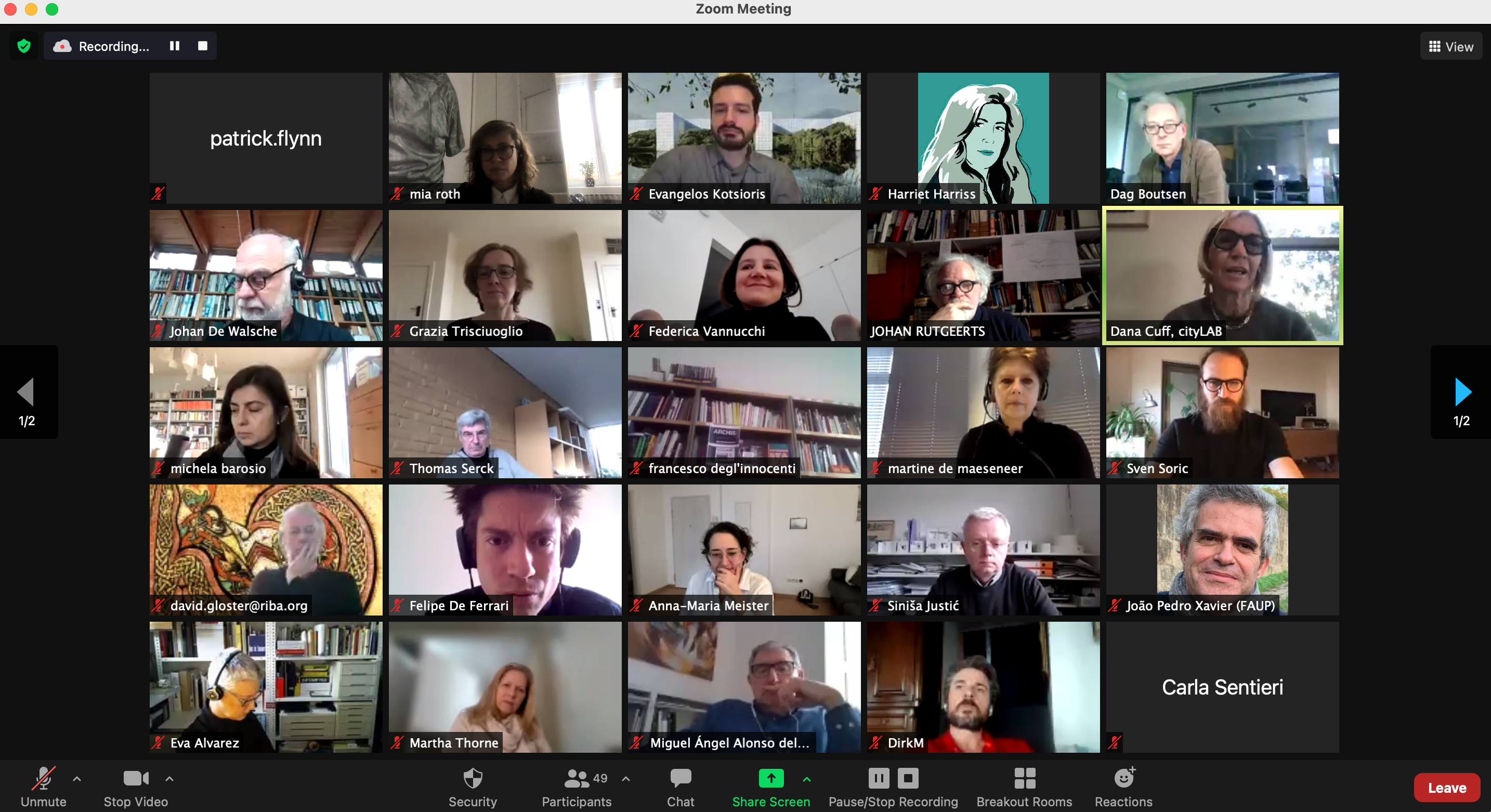
________________________________________________
PROJECT PRESENTATION AND SURVEY LAUNCH AT THE EAAE-ARCC CONFERENCE IN VALENCIA
On November 13th 2020, the Architecture's Afterlife project was presented at the EAAE-ARCC conference 'The Architect and the City' held at the Universitat Politècnica de València. The project coordinator, dr. Harriet Harriss, explained the research goals and launched the survey before introducing the keynote lecture by Carme Pigem of RCR Arquitectes.
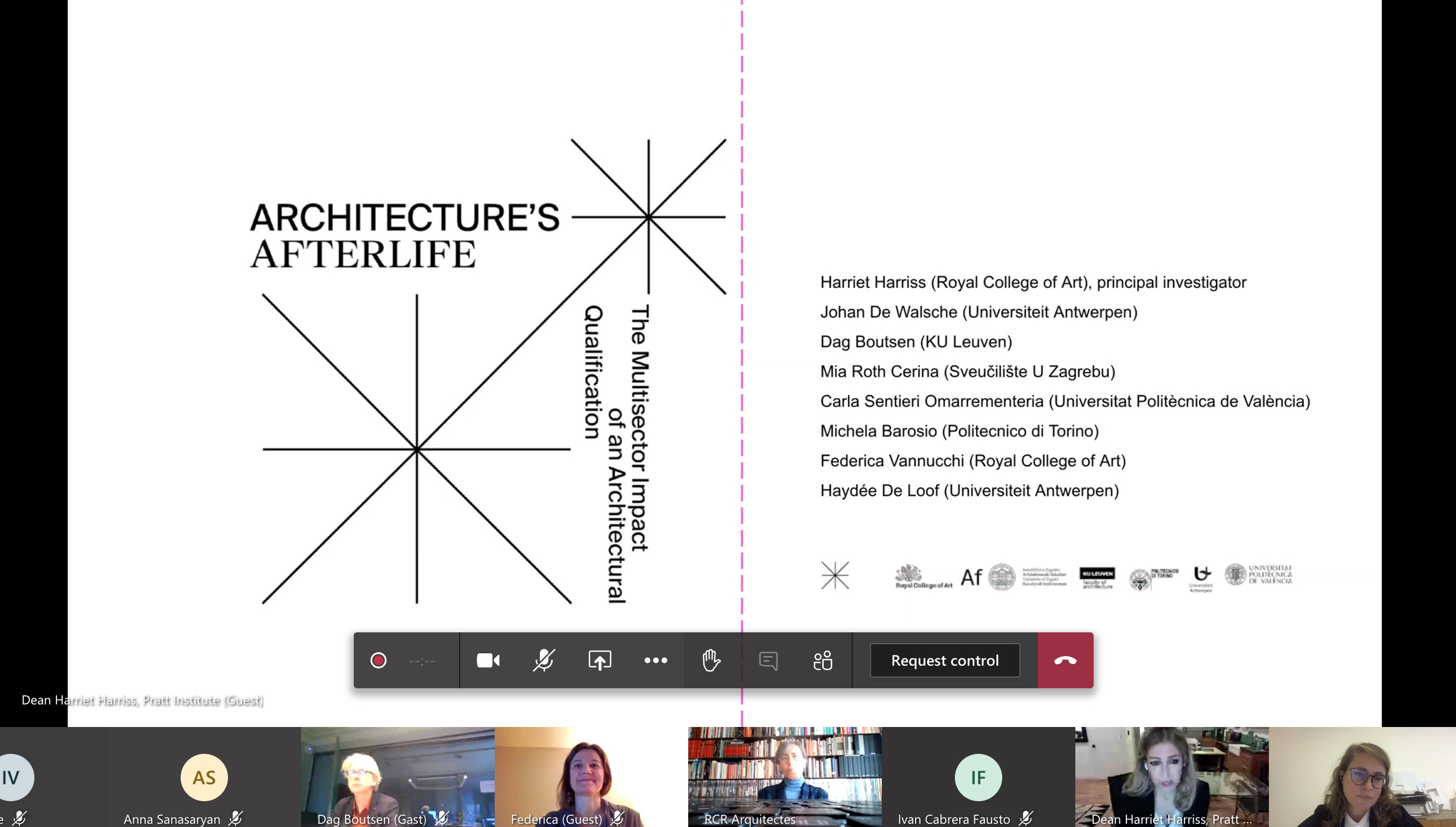
________________________________________________
INCEPTION EVENT, OCT 8th 2020, 8:00 AM EST, 1:00 PM GMT, 2:00 PM CET
On 8 October 2020, we met on-line with the External Advisory Board. The partners presented the Architecture’s Afterlife project and launched the new survey and the website. The presentations were followed by a discussion between the partners and the members of the Advisory Board. Thomas Vonier underlined the importance of defining a clear outcome. He detected some tension about what the project really intends to do: from one side it aims at defining the demands of the workplace in architecture today and whether schools are meeting those demands; from the other, it looks at the value of an architecture education in other fields. He also mentioned a fundamental issue regarding the research which is how many architects are really needed in this environment and what skills and what knowledge are most critical. Lynne Dearborn questioned how an architecture education supports its graduates over the lifetime of their professional careers in whatever field they choose. Anna-Maria Meister stressed the problem of how one defines “leaving the profession,” that is what is an architect outside of a legal definition. David Gloster asked to consider how the profession is not necessarily meeting graduates’ expectations. Patrick Flynn remarked that the teaching of architecture should address not simply the professional demands of today but of 50 years from now, while preparing students for lifelong learning. Roberto Cavallo mentioned the need to incorporate more skills in our schools where a wider understanding of the environment is needed, but, at the same time, schools of architecture can not just pile up requirements. It is essential to understand what is more important and related to the “lifelong learning” that Patrick Flynn has mentioned. Saverio Mecca also stressed the importance of looking at the demands of today as much as of the future. Hrvoje Njiric urged the partners to look at the overproduction of architects in certain countries; the relationship between architecture practice and the economy of each country; and the efficiency of the chambers of architects. Hannah Vowles spoke of the difference between practice, profession, discipline, training, and education. She also urged the partners to look at who gets to enter the field of architecture in relation to class, gender, race and disability.
2:00-2:20 Welcome and Presentation of Partners and Members of the Advisory Board
2:20-2:35 Harriet Harriss (Royal College of Art): Introduction
10 minutes questions
2:45-2:55 Dag Boutsen (KU Leuven) and Michela Barosio (Politecnico di Torino): Aims and Dissemination
2:55-3:00 Carla Sentieri Omarrementeria (Universitat Politècnica de València): Bibliography
10 minutes questions
3:10-3:20 Mia Roth Cerina (Sveučilište U Zagrebu): Launch of the Website
3:20-3:40 Johan De Walsche (Universiteit Antwerpen) and Haydée De Loof (Universiteit Antwerpen): Launch of the Survey
10 min break
3:50-4:25 Discussion
4:25-4:30 Harriet Harriss (Royal College of Art): Final Remarks
View the Inception Event Minutes here
